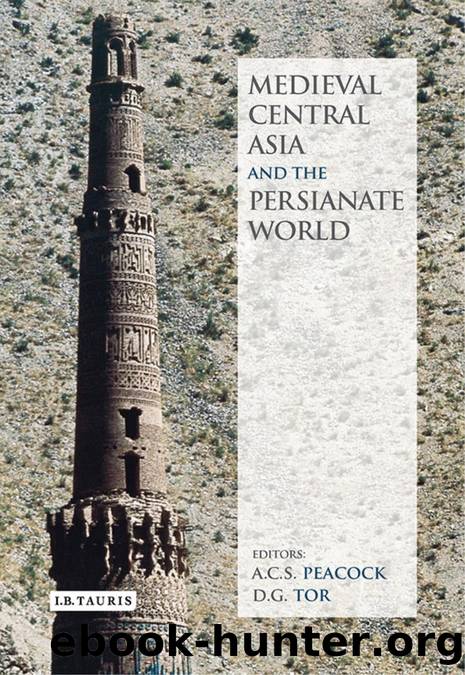Medieval Central Asia and the Persianate World by A.C.S. Peacock;D.G. Tor;

Author:A.C.S. Peacock;D.G. Tor; [Tor;, A.C.S. Peacock;D.G.]
Language: eng
Format: epub
ISBN: 9780857729460
Publisher: Bloomsbury
Published: 2019-11-22T06:00:00+00:00
5
A VENTURE ON THE FRONTIER: ALPTEGINâS CONQUEST OF GHAZNA AND ITS SEQUEL
Minoru Inaba
After the political break-up of the Abbasid caliphate in the first half of the ninth century, the history of Khurasan and MÄ WarÄâ al-Nahr (Transoxiana) is characterised by the further expansion of the Islamic world to the east. The period up to the thirteenth century witnessed a third wave of conquests, especially in Central Asia and South Asia, which were carried out by the non-Arab local Muslims. In Central Asia, the Saffarids and the Samanids played the leading roles in the initial stages of these advances. The former started to expand from Sistan, the southwestern part of present-day Afghanistan, and eventually incorporated Afghanistan and most of Khurasan under their rule. The latter expanded their realm in MÄ WarÄâ al-Nahr and, after emerging victorious from a decisive battle against the Saffarids in 287/900, secured their supremacy in the east. According to Jürgen Paul and Deborah Tor, both dynasties implemented a common policy of conducting vigorous jihÄd against non-Islamic lands to bolster their political legitimacy,1 and this policy of jihÄd is a distinct feature of expansion in the period in question.
It was, however, the Ghaznavids who continued this jihÄd policy and opened a new frontier in north-western India.2 The origin of the Ghaznavids lies in the military conquest of Ghazna, which had once been under the rule of the Saffarids, in the first half of the 350s/ 960s by Alptegin, a Samanid general of military slave origin. In this sense, the Ghaznavids inherited the legacy of these two earlier dynasties, and this paper outlines how these precedents were integrated within the process of Ghaznavid state formation, and how this was related to the frontier features of this region, thereby illustrating not only the economic aspects of the frontier but also the politico-military potential of this eastern frontier of the Islamic world in the period in question.
1. Alptegin
The well-known story of the conquest of the city Ghazna by Alptegin illustrates the characteristics of the Samanid military and jihÄd policy. Alptegin originally had been a Turkish ghulÄm of the Samanid Aḥmad b. IsmÄâÄ«l (r. 295â301/907â914), and was gradually promoted until he became one of the most powerful figures in the army under Nūḥ b. Naá¹£r (r. 331â343/943â954). In the reign of âAbd al-Malik b. Nūḥ (r. 343â350/954â961), powerful local lords, such as Äl-i MuḥtÄj of ChaghÄniyÄn (the region along the SurkhÄndaryÄ river, present-day Uzbekistan) and Turkish generals of slave origin were contending for effective control of the state.3 Alptegin, who was one of these Turkish generals, was most influential in the Samanid court as ḥÄjib-i buzurg (Chief Chamberlain). According to GardÄ«zÄ«, he killed Bakr b. MÄlik (d. 345/956), who was then serving as sipÄhsÄlÄr (Commander-in-Chief) of Khurasan. AbÅ« l-Ḥasan Muḥammad SÄ«mjÅ«rÄ«, who was also a Turkish general, was appointed as Bakrâs successor.4 After AbÅ« l-Ḥasan was dismissed in 349/960â1 Alptegin managed to orchestrate the appointment of his successor, namely AbÅ« Manṣūr Muḥammad b. âAbd al-RazzÄq. Moreover, at the same time, the post
Download
This site does not store any files on its server. We only index and link to content provided by other sites. Please contact the content providers to delete copyright contents if any and email us, we'll remove relevant links or contents immediately.
| Bahrain | Egypt |
| Iran | Iraq |
| Israel & Palestine | Jordan |
| Kuwait | Lebanon |
| Oman | Qatar |
| Saudi Arabia | Syria |
| Turkey | United Arab Emirates |
| Yemen |
Empire of the Sikhs by Patwant Singh(22763)
The Wind in My Hair by Masih Alinejad(4839)
The Templars by Dan Jones(4557)
Rise and Kill First by Ronen Bergman(4544)
The Rape of Nanking by Iris Chang(4022)
12 Strong by Doug Stanton(3419)
Blood and Sand by Alex Von Tunzelmann(3055)
The History of Jihad: From Muhammad to ISIS by Spencer Robert(2504)
Babylon's Ark by Lawrence Anthony(2427)
The Turkish Psychedelic Explosion by Daniel Spicer(2245)
No Room for Small Dreams by Shimon Peres(2235)
Gideon's Spies: The Secret History of the Mossad by Gordon Thomas(2231)
Inside the Middle East by Avi Melamed(2230)
Arabs by Eugene Rogan(2193)
The First Muslim The Story of Muhammad by Lesley Hazleton(2153)
Bus on Jaffa Road by Mike Kelly(2035)
Come, Tell Me How You Live by Mallowan Agatha Christie(2024)
Kabul 1841-42: Battle Story by Edmund Yorke(1921)
1453 by Roger Crowley(1879)
